As urban and rural areas continue to expand, encounters with mice in our homes and gardens have become increasingly common. While these small creatures play an essential role in the ecosystem, they can also be a nuisance and even a health risk when they find their way into our living spaces.
Traditional methods of dealing with mice often involve toxic chemicals and inhumane traps, raising both environmental and ethical concerns. Fortunately, there is a growing interest in safe and eco-friendly alternatives to manage these unwanted guests.
Utilizing natural methods that align with an increased awareness of our environmental responsibilities, we can ensure that we are not harming the planet or other non-target organisms in our efforts to control mice. This guide will explore various humane and green solutions to this age-old problem, focusing on approaches that anyone can implement in their homes and gardens.
Key takeaways
- Seal entry points using materials like steel wool to prevent mice from entering your home.
- Maintain cleanliness by regular cleaning, proper food storage, and reducing clutter to eliminate food sources and hiding spots.
- Use natural deterrents like peppermint oil, essential oil sprays, and ultrasonic repellents to discourage mice.
- Encourage natural predators such as cats, owls, and snakes to help control the mouse population.
- Employ humane traps with natural baits or substances like diatomaceous earth to catch mice without harm.
- Modify the outdoor habitat by keeping the yard clean, sealing entry points, and attracting natural predators.
- Choose eco-friendly methods over harmful chemicals to prevent mouse infestations.
- Create a balanced and harmonious living space by coexisting with wildlife responsibly.
15 Easy ways to get rid of mice naturally
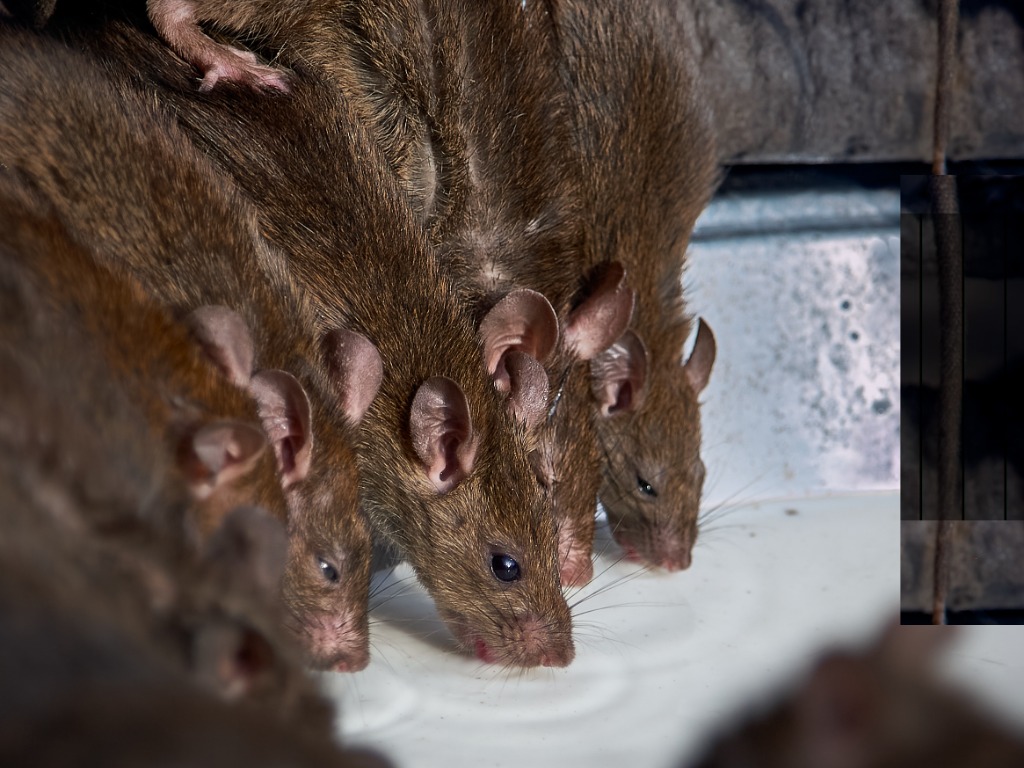
1. Seal Entry Points
- Identify Gaps and Cracks: First, thoroughly inspect your home for any small gaps, cracks, or holes that mice might use as entry points.
- Choose the Right Materials: Utilize materials like steel wool, caulk, or metal mesh, which are more challenging for mice to chew through.
- Seal the Openings: Apply your chosen material to close up these openings securely. Pay particular attention to areas near pipes, vents, and windows, as these can be common entry points for mice.
- Regular Inspections: Periodically re-inspect these areas to ensure the seals remain intact and reseal as needed.
2. Maintain Cleanliness
Regular cleaning routines that include floors, countertops, and dining areas can help ensure no food crumbs or residues are left behind. Proper garbage disposal, with trash cans having lids and being emptied regularly, can prevent attracting mice.
Avoiding clutter in your home can reduce hiding spots for mice, and considering the food storage of pets can also be a key factor in maintaining cleanliness.
3. Proper Food Storage
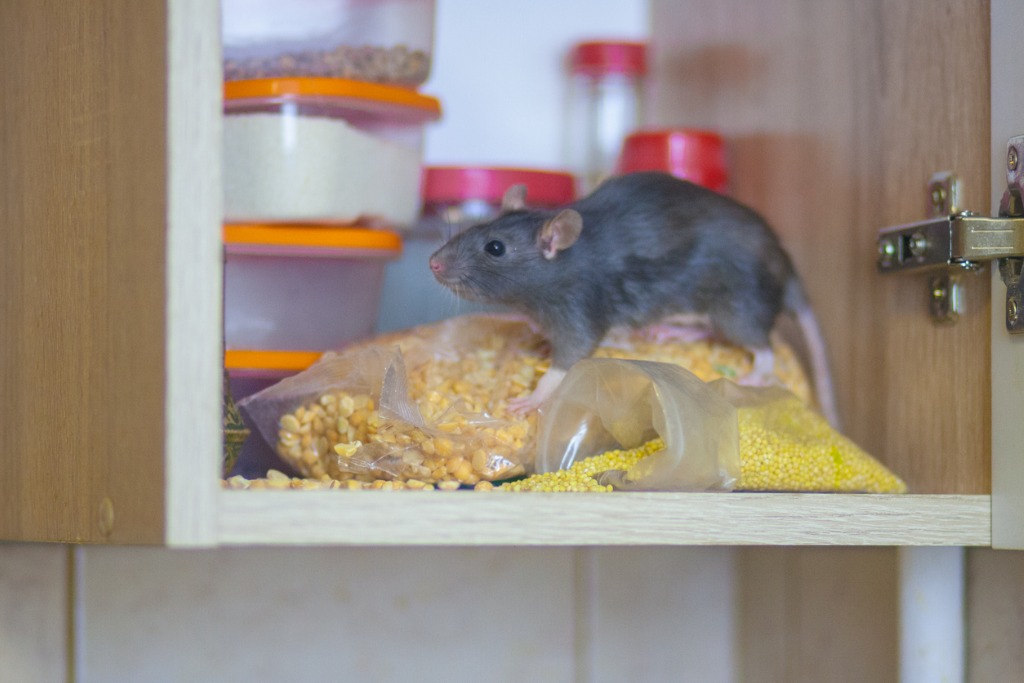
Storing food in airtight containers with tight-fitting lids can keep odors contained and prevent access by mice. Keeping food off the floor and in cabinets or on shelves, along with regular cleaning of pantries and cabinets where food is stored, can make it more challenging for mice to access. Refrigerating perishable items like fresh produce can further deter mice.
4. Peppermint Oil
Peppermint oil is a widely accessible and natural solution for deterring mice. Its intense and fresh scent, while pleasant to humans, is overwhelmingly unpleasant to mice. To utilize peppermint oil as a mouse repellent, you can soak cotton balls or fabric in the oil and place them strategically near potential entry points, such as gaps in walls, doors, or windows.
Regularly inspecting and refreshing these cotton balls ensures that the scent remains potent. Additionally, some homeowners have found success in growing peppermint plants around the property as an extra layer of deterrence.
5. Natural Predators
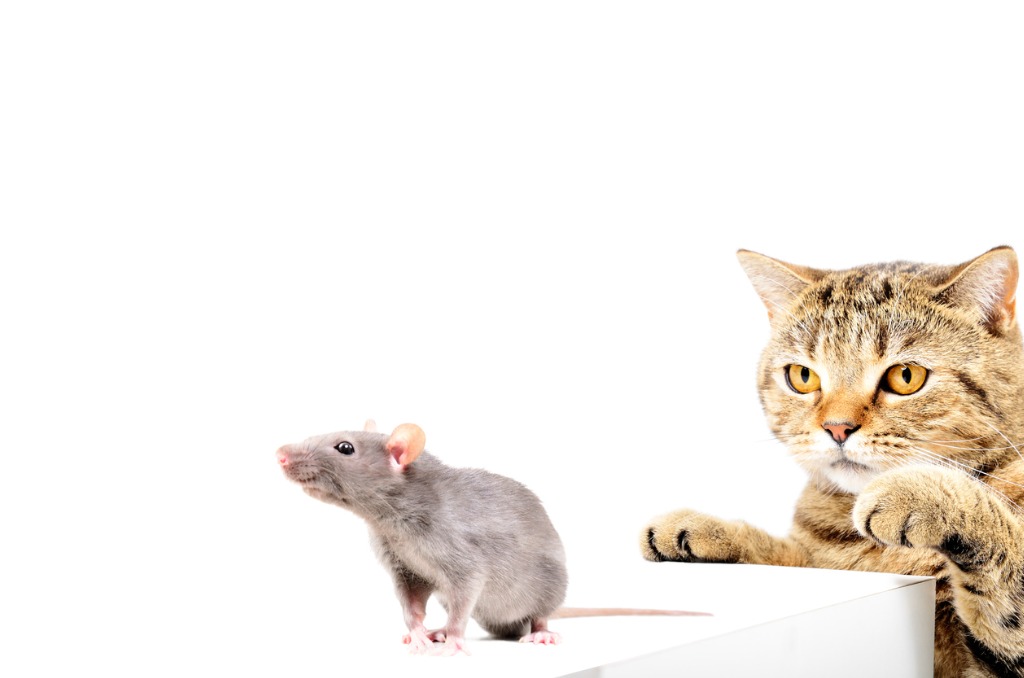
Encouraging the presence of natural predators such as cats, owls, or even some species of snakes can provide an ecological balance that helps control mice. Cats are known for their natural hunting instincts, and having one around can effectively scare off or reduce the mouse population.
For those with outdoor space, installing owl nesting boxes can attract these natural predators, as owls are highly skilled at hunting rodents. Proper research and understanding of local wildlife can guide the best use of natural predators in your specific area, providing a harmonious and environmentally friendly solution.
6. Essential Oils
A variety of essential oils, such as eucalyptus, lavender, and clove, have been found to be effective in repelling mice. Creating a mixture of these oils with water can be used as a spray around the house, specifically targeting entry points and common pathways used by mice. Ensuring a strong enough concentration and frequent application will optimize this method’s effectiveness.
Some individuals also use essential oil diffusers in areas with known mouse activity, providing continuous dispersion of these scents. As with peppermint oil, these smells are usually pleasant to humans but are offensive to mice, making this approach both humane and comfortable for the home’s human occupants.
7. Ultrasonic Repellents
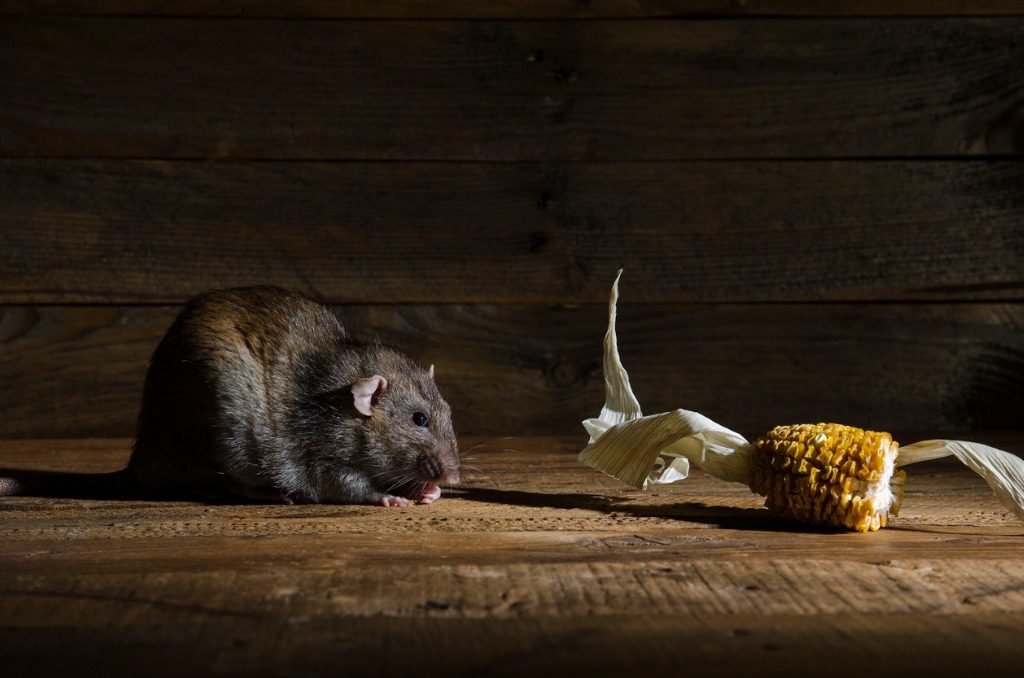
Ultrasonic repellents are electronic devices that emit high-frequency sound waves, typically beyond the range of human hearing. These sounds are very unpleasant for mice and can deter them from inhabiting an area. These devices can be plugged into outlets around your home, especially in areas where mice have been spotted or are likely to enter.
Since the sound waves bounce off walls and objects, placement is crucial to cover the affected area effectively. Note that these devices are considered humane, as they don’t cause physical harm to the mice but merely drive them away.
8. Steel Wool
Mice have the ability to chew through many materials, but steel wool proves to be a significant challenge for them. If you’ve identified small holes or cracks where mice might enter, stuffing these openings with steel wool can be an effective barrier.
For added strength, combining the steel wool with caulking can make the seal even more robust and long-lasting. It’s essential to be thorough in identifying and sealing all potential entry points, as mice need only a very small opening to make their way into a building.
9. DIY Traps
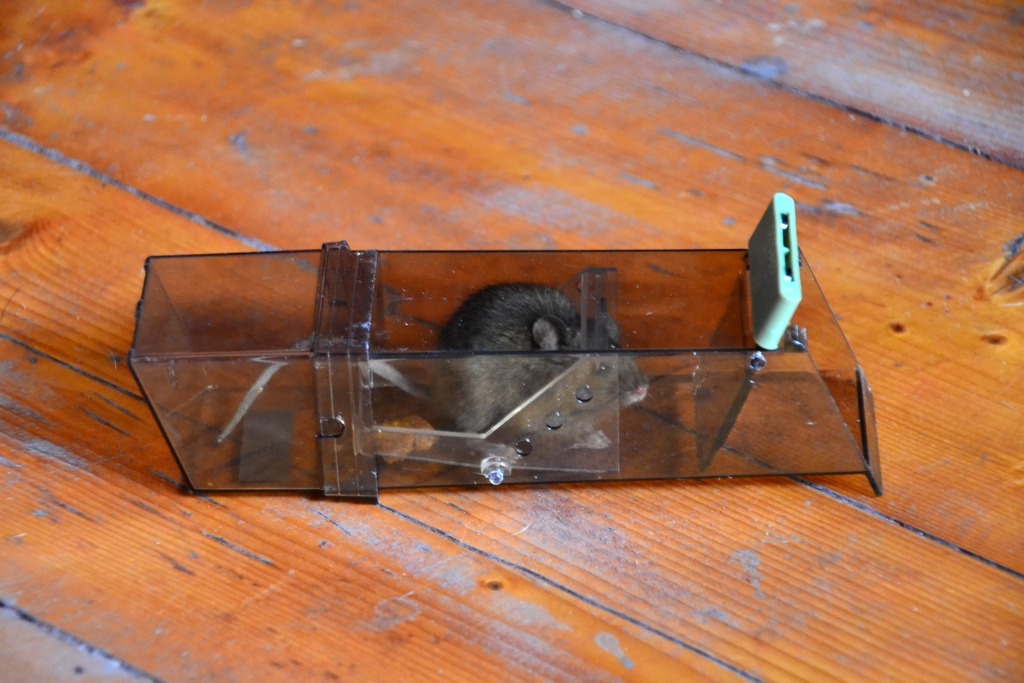
- Bucket Trap: Fill a bucket partially with water, and place a ramp leading to the rim. Put some bait on a suspended platform inside the bucket. Mice will climb the ramp and fall into the bucket without being able to climb back out.
- Bottle Trap: Cut the top off a plastic bottle and invert it, creating a funnel into the body of the bottle. Place bait inside, and mice will enter but find it difficult to escape.
- Humane Box Trap: Utilize a small box propped up with a stick and a string. Place bait inside, and when the mouse enters, pull the string, allowing the box to trap the mouse without harm.
10. Natural Bait
Utilizing natural baits in traps can be a humane way to catch mice. Ingredients like peanut butter, nuts, seeds, or fruits can be highly appealing to mice and are often used in both humane and DIY traps. By using substances that are organic and non-toxic, the mice are attracted to the traps without any harm to them or other non-target animals.
Natural baits can be employed in conjunction with other methods like humane traps or the DIY traps previously mentioned, offering an ethical and environmentally friendly approach.
11. Diatomaceous Earth
Diatomaceous earth is a non-toxic powder made from the fossilized remains of tiny aquatic organisms called diatoms. It works by getting into the joints and exoskeletons of insects, causing them to dehydrate and die, but it is generally considered safe for larger animals, including pets. Though it’s primarily used against insects, it can also deter mice by creating an uncomfortable walking surface.
By sprinkling diatomaceous earth around areas where mice are likely to enter, you can create a barrier that they’ll likely avoid. It’s essential to use food-grade diatomaceous earth to ensure safety for both humans and pets.
12. Plug-in Repellents
Similar to ultrasonic repellents, plug-in repellents emit sounds or vibrations that are unpleasant to mice, causing them to steer clear of the area. These devices are plugged into standard wall outlets and often combine ultrasonic frequencies with electromagnetic technology to repel not only rodents but also insects.
The advantage of plug-in repellents is their ease of use and maintenance-free operation. By strategically placing them around the home, particularly in attics, basements, or near known entry points, you can provide a consistent and humane deterrent against mice.
13. Habitat Modification
Altering the environment around your home can play a crucial role in deterring mice. This includes trimming overgrown bushes and trees that may provide shelter, removing piles of debris or wood where mice may nest, and keeping grass cut short to reduce hiding spots.
Ensuring that water sources like leaky faucets are fixed can also remove an essential resource for mice. By making the area around your home less hospitable to mice, you can discourage them from settling nearby and attempting to enter your home.
14. Baking Soda and Sugar
A mixture of baking soda and sugar can be used as a natural rodent control method. When ingested by mice, the baking soda reacts with the stomach acid and produces carbon dioxide, leading to internal distress. By mixing equal parts of baking soda and sugar and placing it where mice frequent, you can create an effective deterrent.
While this method is considered more lethal than some of the others, it is a natural alternative to conventional poisons and can be used if other methods have proven ineffective.
15. Cayenne Pepper Spray
Cayenne pepper’s strong and spicy aroma can effectively repel mice. You can make a natural spray by mixing cayenne pepper with water and a small amount of dish soap to help the mixture adhere to surfaces. Spray this mixture around entry points, along baseboards, or in areas where mice have been detected.
The strong smell of the cayenne pepper acts as a deterrent, and while it doesn’t harm the mice, they find it very unpleasant. Regular reapplication may be necessary to maintain its effectiveness.
15. Cayenne Pepper Spray
Cayenne pepper’s strong and spicy aroma can effectively repel mice. You can make a natural spray by mixing cayenne pepper with water and a small amount of dish soap to help the mixture adhere to surfaces. Spray this mixture around entry points, along baseboards, or in areas where mice have been detected.
The strong smell of the cayenne pepper acts as a deterrent, and while it doesn’t harm the mice, they find it very unpleasant. Regular reapplication may be necessary to maintain its effectiveness.
Suggestions for outdoor mouse prevention?
Outdoor mouse prevention requires a multifaceted approach that combines natural deterrence methods and habitat modifications. Here are some suggestions that specifically focus on preventing mice in outdoor areas:
- Keep Yard Clean: Regularly trim shrubs, mow the lawn, and remove debris to reduce hiding spots.
- Store Food and Waste Properly: Use tight-fitting lids on trash cans and store pet food properly.
- Seal Entry Points: Inspect and seal cracks in outdoor structures like sheds or garages.
- Use Natural Repellents: Plant peppermint or use sprays made of cayenne pepper or essential oils.
- Encourage Predators: Attract natural predators like owls or cats if suitable.
- Set Humane Traps: Utilize water traps or other humane traps with natural bait if needed.
- Modify Habitat: Make the outdoor environment less inviting by filling gaps and reducing access to water.
- Avoid Chemicals: Opt for natural deterrents like diatomaceous earth instead of harmful chemicals.
- Inspect Outdoor Items: Regularly check furniture and equipment for signs of nesting.
- Consult a Professional if Needed: Seek eco-friendly pest control if the problem persists.
By following these streamlined tips, you can maintain an outdoor space that is less attractive to mice while adhering to natural and humane practices.
Conclusion
Managing and preventing a mouse problem doesn’t have to involve harmful chemicals or inhumane methods. By embracing a holistic approach that combines cleanliness, natural deterrents, habitat modifications, and responsible trapping, you can create a balanced and humane strategy to keep mice at bay.
These practices are not only effective but also align with eco-friendly and ethical principles. Whether indoors or outdoors, understanding the behaviors of mice and thoughtfully applying these natural techniques ensures that your living spaces remain comfortable and mouse-free, all while preserving the harmony of the surrounding environment.
It’s a testament to the idea that with a little creativity and commitment to natural solutions, we can coexist with wildlife in a responsible and respectful manner.
Frequently asked questions
Answer: There are several eco-friendly methods to prevent mice from entering your home. These include sealing entry points with materials like steel wool, maintaining cleanliness to eliminate food sources, using natural repellents like peppermint oil or essential oils, encouraging natural predators, and employing humane traps with natural bait.
Answer: Essential oils such as peppermint, eucalyptus, lavender, and clove can be effective in repelling mice. You can create a mixture of these oils with water and spray it around entry points and common pathways used by mice. Diffusers can also be used to disperse these scents continuously. These oils are pleasing to humans but offensive to mice, making them a humane and comfortable solution.
Answer: Diatomaceous earth is a non-toxic powder made from fossilized aquatic organisms called diatoms. It works by getting into the joints and exoskeletons of insects, causing them to dehydrate and die. Sprinkling diatomaceous earth around areas where mice are likely to enter creates an uncomfortable walking surface, deterring them. Ensure you use food-grade diatomaceous earth to maintain safety for humans and pets.
Answer: Ultrasonic repellents are electronic devices that emit high-frequency sound waves beyond the range of human hearing. These sound waves are unpleasant for mice and can deter them from inhabiting an area. These devices can be plugged into outlets around your home, especially in areas where mice have been spotted or are likely to enter. They are considered humane as they don’t physically harm mice, just discourage them.
Answer: Outdoor mouse prevention involves a combination of methods. You should keep your yard clean by trimming shrubs, mowing the lawn, and removing debris. Store food and waste properly with tightly sealed trash cans and proper pet food storage. Seal entry points in outdoor structures, use natural repellents like peppermint or cayenne pepper, encourage natural predators, set humane traps if needed, modify the habitat, avoid chemicals, and regularly inspect outdoor items for signs of nesting. If the problem persists, consider seeking eco-friendly pest control.

